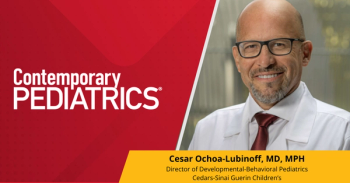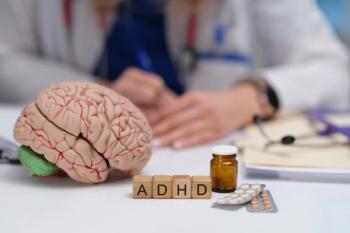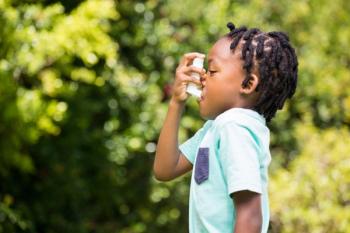
- Consultant for Pediatricians Vol 9 No 11
- Volume 9
- Issue 11
Anxiety Disorders in Children: Common-But Often Missed
The American Academy ofChild and Adolescent Psychiatry recommendsroutine screening for anxiety inchildhood, querying various sources (child,parent, teacher) about anxiety symptoms,assessing for comorbid disorders,and evaluating severity and functionalimpairment. Transient and developmentallyappropriate worries and fears need tobe distinguished from anxiety disorders.Somatic symptoms, such as headache orstomachache, often accompany anxiety.A child’s anxiety may manifest as crying,irritability, or other behaviors that maybe misunderstood by adults as disobedience.Self-report measures can helpscreen for anxiety symptoms and monitortreatment response. Psychotherapy isthe initial treatment of children withanxiety. Pharmacotherapy with selectiveserotonin reuptake inhibitors may benecessary for those with moderate tosevere anxiety. In these children, theaddition of cognitive-behavioral therapymay improve functioning better thaneither intervention alone.
ABSTRACT: The American Academy of Child and Adolescent Psychiatry recommends routine screening for anxiety in childhood, querying various sources (child, parent, teacher) about anxiety symptoms, assessing for comorbid disorders, and evaluating severity and functional impairment. Transient and developmentally appropriate worries and fears need to be distinguished from anxiety disorders. Somatic symptoms, such as headache or stomachache, often accompany anxiety. A child’s anxiety may manifest as crying, irritability, or other behaviors that may be misunderstood by adults as disobedience. Self-report measures can help screen for anxiety symptoms and monitor treatment response. Psychotherapy is the initial treatment of children with anxiety. Pharmacotherapy with selective serotonin reuptake inhibitors may be necessary for those with moderate to severe anxiety. In these children, the addition of cognitive-behavioral therapy may improve functioning better than either intervention alone.
Anxiety disorders are one of the most common psychiatric disorders in children and adolescents, but they often go undetected or untreated. Identification and effective treatment of childhood anxiety disorders can decrease the negative impact of these disorders on academic and social functioning in youth and their persistence into adulthood. Because of the national shortage of child and adolescent psychiatrists, pediatricians are increasingly called on to be frontline partners with child mental health professionals to coordinate care- with screening and early identification as well as with multimodal treatment of childhood anxiety disorders.
Several statewide consultation programs now exist to aid pediatricians and other pediatric primary care providers who diagnose and treat anxiety and other psychiatric disorders. Illinois DocAssist is one such model.1 Pediatricians are encouraged to identify similar programs in their state.
This article reviews the screening and assessment of childhood anxiety and its treatment-both nonmedical and pharmacological. The following anxiety disorders are discussed: separation anxiety disorder (SAD), generalized anxiety disorder (GAD), specific phobia, panic disorder, social phobia, and selective mutism. Obsessive-compulsive disorder and posttraumatic stress disorder are not covered in this article.
PREVALENCE AND COMORBIDITY
The prevalence of any anxiety disorder in youths ranges from 2% to 4%, with 6- and 12-month estimates between 10% and 20%, and lifetime estimates only slightly higher.2 Anxiety disorders in preschool children follow patterns similar to those in older children. The impact of anxiety symptoms in young children may be clinically significant even if full DSM-IVTR criteria for an anxiety disorder diagnosis are not met. Early intervention and treatment can prevent further impairment over time.
One anxiety disorder is often comorbid with another anxiety disorder, as well as with other psychiatric disorders-especially depression and attention-deficit/hyperactivity disorder (ADHD). ADHD is present in 30% of children and adolescents with anxiety disorders.3 Anxiety often precedes depression; the co-occurrence of anxiety and depression increases with age and is associated with greater impairment. Furthermore, the presence of anxiety disorders in childhood increases the risk of abusing alcohol in adolescence.
SCREENING AND ASSESSMENT
Assess for anxiety. The American Academy of Child and Adolescent Psychiatry (AACAP) Practice Parameter for the Assessment and Treatment of Children and Adolescents With Anxiety Disorders recommends the following: routine screening for anxiety in childhood, gathering information from various sources (child, parent, teacher) about anxiety symptoms, assessing for comorbid disorders, and evaluating severity and functional impairment.3 Children may be more aware of their inner distress (GAD), parents are more likely to appreciate the impact of anxiety on family life (SAD), and teachers are skilled at observing social functioning relative to same-age peers (social phobia).
Distinguish developmentally normal anxiety from abnormal. During the diagnostic evaluation, clinicians need to distinguish transient and developmentally appropriate worries and fears from anxiety disorders. In addition, the impact of stressors or traumas on the development or maintenance of anxiety symptoms needs to be assessed.
Common fears among infants include loud noises, being dropped, and later normal separation anxiety. Toddlers typically experience fear of imaginary creatures (monsters) and darkness. From age 5 to 6 years, children experience worries about physical well-being (eg, injury, kidnapping); later, fears of natural events (storms) develop. School-aged children worry about school performance, behavioral competence, rejection by peers, health, and illness. In adolescence, worries about social competence, social evaluation, and psychological well-being are prominent.
Recognize somatic and behavioral symptoms of anxiety. Somatic symptoms, such as headaches, abdominal complaints, muscle tension, restlessness, and difficulty in sleeping, commonly accompany childhood anxiety disorders. Early screening for anxiety can help decrease excessive medical workups. Assessing somatic symptoms before initiating treatment can decrease later confusion with adverse effects of medication.
Anxiety disorders in children may present with behavioral symptoms, such as crying, irritability, angry outbursts or tantrums, and argumentativeness. These behaviors may be misunderstood by adults as oppositionality or disobedience, when in fact they could represent the child’s expression of overwhelming fear or effort to avoid the anxiety-provoking object or situation at all costs. Children with anxiety disorders may not recognize their fears or worry as unreasonable or excessive, even when it is evident to others that their anxiety and avoidance impairs their functioning and judgment in various situations.
Understand symptoms of specific anxiety disorders.Table 1 reviews the clinical presentation for each anxiety disorder and considersthe anxious thoughts, physical sensations, and behavior related to children and adolescents.
Self-report measures for anxiety, such as the Multidimensional Anxiety Scale for Children (MASC)4 and Screen for Child Anxiety Related Emotional Disorders (SCARED),5,6 can help clinicians screen for anxiety symptoms at baseline and monitor response to treatment. The Selective Mutism Questionnaire has parent and teacher report forms for selective mutism.7 Children and parents can use visual analogues, such as a feelings thermometer, to rate severity of anxiety symptoms and impairment during the diagnostic evaluation. Younger children may prefer other visual tools for rating, such as smiley faces and upset faces.
Pediatricians should routinely refer children and adolescents with anxiety disorders to mental health professionals so that psychotherapy, including cognitive-behavioral therapy (CBT), can be initiated early. Medications can reduce the severity of anxiety symptoms; however, psychotherapy can help the child and family understand how anxiety works and can help the child learn coping skills that target the anxious thoughts and behaviors to decrease avoidance of anxiety- provoking stimuli and reduce impairment. Establishing a relationship with local psychotherapists or regional anxiety centers can facilitate referrals. Suggested readings for clinicians, parents, and youths that are helpful in the treatment process are provided at the end of the article.
DIFFERENTIAL DIAGNOSIS
In the assessment of childhood anxiety disorders, it is important to consider psychiatric conditions and physical conditions that may mimic anxiety symptoms (AACAP Practice Parameter 2007).3 The adverse effects of certain medications can also mimic anxiety symptoms.
Psychiatric conditions that may present with symptoms similar to anxiety disorders include ADHD (motor restlessness, fidgeting, inattention); psychotic disorders (restlessness, agitation, or social withdrawal); pervasive developmental disorders, especially Asperger disorder (social awkwardness, social withdrawal, social skills deficits, communication deficits, repetitive behaviors, over-adherence to routines); learning disorders (persistent worries focused on school performance, school refusal); bipolar disorder (restlessness, irritability, insomnia); and depression (poor concentration, insomnia, somatic complaints).
Physical conditions to consider in the differential include hyperthyroidism, caffeinism (including carbonated beverages), migraine, asthma, seizure disorders, and lead intoxication. Less common conditions in youths are hypoglycemic episodes, pheochromocytoma, a CNS disorder (eg, delirium, brain tumors), and cardiac arrhythmias.
Medications that may cause anxiety-like symptoms include the following:
• Prescription: antiasthmatics, sympathomimetics, corticosteroids, selective serotonin reuptake inhibitors (SSRIs), antipsychotics (akathisia), haloperidol, pimozide (neuroleptic-induced SAD), and atypical antipsychotics.
• Nonprescription: diet pills, antihistamines, and cold medicines.
NONMEDICAL INTERVENTIONS
Treatment of children with anxiety disorders of mild severity and minimal impairment should begin with psychotherapy.3
CBT. Exposure-based CBT has empirical support from wait-list–controlled studies for the treatment of childhood anxiety disorders and is the psychotherapy of choice for this population.8 However, studies that compare CBT with alternative psychotherapies have not been done.
Velting and colleagues9 describe several components of CBT for childhood anxiety disorders as follows:
• Psychoeducation with child and parents about anxiety and CBT for anxiety disorders.
• Somatic management skills training: self-monitoring, muscle relaxation, diaphragmatic breathing, relaxing imagery.
• Cognitive restructuring: challenging negative thoughts and expectations, learning positive self-talk.
• Practicing problem solving: generate several potential solutions for anticipated challenges and generate a realistic action plan ahead of time.
• Exposure methods: imaginal and live exposure with gradual desensitization to feared stimuli.
• Relapse prevention plans: booster sessions and coordination with parents and school.
Along with these components, parents are taught to provide consistent and frequent positive reinforcement for the child’s efforts and successes. This increases the child’s motivation to attempt exposures that initially increase anxiety and discomfort levels. Over the course of treatment, learning to self-reward is emphasized. Parents learn anxiety-management skills so they can function as CBT coaches. Clinicians need to be flexible in considering child and family factors, comorbidity, and psychosocial stressors to achieve treatment success.10
Family interventions. Family assessment can help clinicians identify possible environmental triggers and reinforcements, parenting styles (especially controlling, critical, overprotective), family responses to the child’s anxiety symptoms, parental expectations, and coping strategies modeled by parents.11 In addition, if anxiety disorders are present in either or both parents, psychoeducation and treatment for parental anxiety disorders should be considered.
Family interventions that strengthen family problem-solving skills and communication, reduce parental anxiety, and foster parenting skills that decrease avoidant coping and encourage self-efficacy in the child can be helpful for anxious children. 3 Parental involvement in treatment is critical when the parent is anxious.
School interventions. Classroom- based accommodations can assist the child with an anxiety disorder that impairs school functioning. A key worker can be identified in the school setting to assist the child with problem-solving or anxiety-management strategies. The school is encouraged to help the child reduce anxiety and remain at school whenever possible to reduce the risk of the child refusing to go to school. If performance or test anxiety is present, then testing in a private environment with extended testing time may be helpful. Accommodations for the anxiety disorder can be written into the student’s 504 Plan or Individualized Educational Plan.
PHARMACOTHERAPY
For moderate to severe anxiety, medication may be necessary. Medications can reduce the severity of anxiety symptoms so that the child can participate in CBT. Placebo-controlled trials have demonstrated short-term effectiveness of SSRIs for the treatment of childhood anxiety disorders (Table 2).12-18
SSRIs. These medications are the first-line pharmacological treatment for anxiety disorders in children and adolescents.19 Although the FDA has issued a black box warning regarding increased risk of suicide with use of antidepressants, including SSRIs, in this population, the benefit to risk ratio for anxiety disorders may be more favorable than that for depression. 19 Clinicians need to monitor for worsening depression, agitation, or suicidality, particularly at the beginning of medication treatment or when there is a change in dosage.
SSRIs have not been compared with one another for the treatment of childhood anxiety disorders, but clinicians can consider adverse-effect profile, duration of action, patient adherence or preference, and positive response in a first-degree relative. Some differences in dosing effects by age are emerging for SSRIs, with children showing more adverse effects and higher peak plasma concentration than adolescents at similardoses. Clinicians are advised to start at low doses, monitor adverse effects closely, and titrate slowly on the basis of treatment response and tolerability.
Starting dosage, titration, and duration. In young children who have anxiety disorders or selective mutism, using the liquid form of an SSRI medication and starting at a very low dosage (such as the equivalent of 1 to 2 mg/d of fluoxetine) may reduce the likelihood of adverse effects. Young children benefit from lower dosages of SSRIs than school-age children, and school-age children benefit from lower dosages than adolescents. Clinicians can consider increasing the SSRI dosage by the fourth week of medication treatment if significant improvement in anxiety severity or impairment is not achieved.13,15 Studies of long-term risks and benefits of SSRIs are limited.
Clinicians can consider a medication- free trial after 1 year of SSRI treatment for those children who achieve marked improvement in anxiety or depressive symptoms and impairment. This decrease or discontinuation of medication can occur during a low-stress period, with close monitoring for relapse so that medication can be restarted promptly if necessary.
Adverse effects. SSRIs have been well tolerated by children with anxiety disorders. Common adverse effects include GI symptoms, headache, increased motor activity, and insomnia. These adverse effects are often mild or temporary. Less common adverse effects include disinhibition and more severe forms of behavioral activation, such as agitation or aggression. These adverse effects may subside by reducing the dosage of the SSRI. Disinhibition can present with acute symptoms of defiance or increased emotional reactivity and needs to be distinguished from positive treatment effects, such as increased initiative and assertiveness in anxious children.
A study of paroxetine in youths with social phobia showed some significant adverse effects, such as vomiting, decreased appetite, and insomnia, in the active-treatment group.16 Relative suicide risk in this trial was elevated, although not statistically significant.
Monitoring. The clinician needs to routinely screen for symptoms of bipolar disorder or a family history of bipolar disorder before initiating treatment with an SSRI or other antidepressant, because these medications may exacerbate mood swings, irritability, or mania. In addition, it is important to obtain a family history, including previous medication trials, and evaluation of psychosocial factors that may predispose a patient to risk for aggression or suicide.19
Medications other than SSRIs. The safety and efficacy of medications other than SSRIs for the treatment of childhood anxiety disorders have not been established. Venlafaxine, tricyclic antidepressants (TCAs), buspirone, and benzodiazepines have been used as clinical alternatives, either alone or in combination with SSRIs. Switching to another SSRI to treat resistant anxiety has been shown to be helpful, and adding a second type of medication may be useful when there is a partial response. Comorbid diagnoses must be considered in the selection of medication.3,20
Venlafaxine. Although the combined results were positive, only 1 of 2 trials with extended-release venlafaxine showed significant improvements relative to placebo in children with GAD.18 On the basis of significant changes in blood pressure, pulse, and cholesterol levels with treatment, venlafaxine is considered only after several failed trials of SSRIs. Also, relative risk of suicidality with venlafaxine may be higher than with SSRIs.
TCAs. These medications are not often used in children because of the need for close cardiac monitoring and greater medical risks with overdose. Controlled trials of TCAs for youths with anxiety disorders have demonstrated conflicting results.
Buspirone. This drug is used clinically as an alternative to SSRIs for GAD in children and adolescents or as an adjuvant medication, but there are no published controlled studies for its use in children with anxiety disorders. Buspirone may be tolerated at higher doses in adolescents than in children with anxiety. The most common adverse effects are light-headedness, headache, and dyspepsia.
Benzodiazepines. These agents have not shown efficacy in controlled trials in children with anxiety disorders. Clinically, they can be used short-term to achieve acute reduction in severe anxiety symptoms while an SSRI is started or to permit initiation of the exposure phase of CBT for children who refuse to go to school or who have panic disorder or specific phobia. However, benzodiazepines should be used cautiously in youths because of the risk of developing dependence, and they are contraindicated in youths with a history of substance abuse.3,20 Possible adverse effects include sedation, disinhibition, behavioral dyscontrol, and cognitive impairments. If benzodiazepine treatment is stopped abruptly, there is a risk of severe withdrawal symptoms, including insomnia, anxiety, GI upset, and seizures.
Although there are no controlled medication studies in youths with panic disorder, clinically, SSRIs are considered first-line pharmacotherapy for panic disorder. Benzodiazepines (clonazepam or lorazepam) may be combined with SSRIs in the short term when severe panic symptoms are present.20
Combining psychotherapy with medication. Combined therapy maybe necessary in children with moderate to severe anxiety, when treating a comorbid disorder, or when there is a partial response to psychotherapy alone.21
To investigate monotherapies versus combined treatment, the Child/Adolescent Anxiety Multimodal Study (CAMS), a placebo-controlled trial in youths with moderate to severe SAD, GAD, and/or social phobia, compared CBT, sertraline, or placebo with combination treatment with sertraline and CBT.17 CBT (60% improved) and sertraline (55% improved) showed relatively equal efficacy and were superior to placebo (24% improved) for the treatment of childhood anxiety disorders, and the combination of CBT and sertraline (81% improved) had a response rate superior to either modality alone. All 3 of these active treatments were recommended, with clinicians considering availability, family preferences, and cost in choosing a treatment.17 Unfortunately, CBT is not widely available and thus may not be a treatment option for many anxious children until more clinicians in the community and schools integrate CBT into their practices.
SUGGESTED READINGS ON ANXIETY DISORDERSFor Clinicians:
• Connolly SD, Bernstein GA; Work Group on Quality Issues. Practice
parameter for the assessment and treatment of children and adolescents with
anxiety disorders. J Am Acad Child Adolesc Psychiatry. 2007;46:267-283.
• Connolly SD, Suarez LM. Generalized anxiety disorder, specific phobia, panic
disorder, social phobia and selective mutism. In: Dulcan MK, ed. Dulcan’s
Textbook of Child and Adolescent Psychiatry. Arlington, VA: American Psychiatric
Publishing, Inc; 2009.
• Ollendick TH, March JS, eds. Phobic and Anxiety Disorders in Children and
Adolescents. New York: Oxford University Press; 2004.
• Rapee RM, Wignall A, Hudson J, Schniering C. Treating Anxious Children and
Adolescents: An Evidence-Based Approach. Oakland, CA: New Harbinger
Publications; 2000.
For Parents:
• McHolm AE, Cunningham CE, Vanier MK. Helping Your Child With Selective
Mutism: Steps to Overcome a Fear of Speaking. Oakland, CA: New Harbinger
Publications; 2005.
• Rapee RM, Wignall A, Spence SH, Cobham V. Helping Your Anxious Child:
A Step-by-Step Guide for Parents. Oakland, CA: New Harbinger Publications; 2008.
For Children and Adolescents:
• Huebner D. What to Do When You Worry Too Much: A Kid’s Guide to
Overcoming Anxiety. Washington, DC: Magination Press; 2006.
• Tompkins MA, Martinez KA. My Anxious Mind: A Teen’s Guide to Managing
Anxiety and Panic. Washington, DC; Magination Press; 2009.
References:
1. Illinois DocAssist. University of Illinois at Chicago Department of Psychiatry. http://www.psych.uic.edu/ DOCASSIST. Accessed October 11, 2010.
2. Costello EJ, Egger HL, Angold A. Developmental epidemiology of anxiety disorders. In: Ollendick TH, March JS, eds. Phobic and Anxiety Disorders in Children and Adolescents. New York: Oxford UniverÂsity Press; 2004:334-380.
3. Connolly SD, Bernstein GA; Work Group on Quality Issues. Practice parameter for the assessÂment and treatment of children and adolescents with anxiety disorders. J Am Acad Child Adolesc Psychiatry. 2007;46:267-283.
4. March JS, Parker JD, Sullivan K, et al. The MultiÂdimensional Anxiety Scale for Children (MASC): factor structure, reliability, and validity. J Am Acad Child Adolesc Psychiatry. 1997;36:554-565.
5. Screen for Child Anxiety Related Emotional Disorders (SCARED). Child Version. University of Pittsburgh Department of Psychiatry. Assessment Instruments. http://www.wpic.pitt.edu/research/ ScaredChild-final.pdf. Accessed October 4, 2010.
6. Screen for Child Anxiety Related Emotional DisÂorders (SCARED). Parent Version. University of Pittsburgh Department of Psychiatry. Assessment Instruments. http://www.wpic.pitt.edu/research/ ScaredParent-final.pdf. Accessed October 4, 2010.
7. Bergman RL, Keller ML, Piacentini J, Bergman AJ. The development and psychometric properties of the Selective Mutism Questionnaire. J Clin Child Adolesc Psychol. 2008;37:456-464.
8. Compton SN, March JS, Brent D, et al. CogniÂtive-behavioral psychotherapy for anxiety and depressive disorders in children and adolescents: an evidence-based medicine review. J Am Acad Child Adolesc Psychiatry. 2004;43:930-959.
9. Velting ON, Setzer NJ, Albano AM. Update on and advances in assessment and cognitive-behavÂioral treatment of anxiety disorders in children and adolescents. Prof Psychol Res Pract. 2004;35:42-54.
10. Albano AM, Kendall PC. Cognitive-behavioural therapy for children and adolescents with anxiety disorders: clinical research advances. Int Rev Psychiatry. 2002;14:129-134.
11. Connolly SD, Suarez LM. Generalized anxiety disorder, specific phobia, panic disorder, social phobia and selective mutism. In: Dulcan MK, ed.
Dulcan’s Textbook of Child and Adolescent Psychiatry. In press.
12. Black B, Uhde TW. Treatment of elective mutism with fluoxetine: a double-blind, placebo-controlled study. J Am Acad Child Adolesc Psychiatry. 1994;33:1000-1006.
13. The Research Unit on Pediatric PsychopharmaÂcology Anxiety Study Group. Fluvoxamine for the treatment of anxiety disorders in children and adoÂlescents. N Engl J Med. 2001;344:1279-1285.
14. Rynn MA, Siqueland L, Rickels K. Placebo-controlled trial of sertraline in the treatment of children with generalized anxiety disorder. Am J Psychiatry. 2001;158:2008-2014.
15. Birmaher B, Axelson DA, Monk K, et al. Fluoxetine for the treatment of childhood anxiety disorders. J Am Acad Child Adolesc Psychiatry. 2003;42:415-423.
16. Wagner KD, Berard R, Stein MB, et al. A multiÂcenter, randomized, double-blind, placebo-controlled trial of paroxetine in children and adolescents with social anxiety disorder. Arch Gen Psychiatry. 2004;61:1153-1162.
17. Walkup JT, Albano AM, Piacentini J, et al. Cognitive behavioral therapy, sertraline, or a combiÂnation in childhood anxiety. N Engl J Med. 2008; 359:2753-2766.
18. Rynn MA, Riddle MA, Yeung PP, Kunz NR. Efficacy and safety of extended-release venlafaxine in the treatment of generalized anxiety disorder in children and adolescents: two placebo-controlled trials. Am J Psychiatry. 2007;164:290-300.
19. Seidel L, Walkup JT. Selective serotonin reupÂtake inhibitor use in the treatment of pediatric nonâobsessive-compulsive disorder anxiety disorÂders. J Child Adolesc Psychopharmacol. 2006;16: 171-179.
20. Reinblatt SP, Riddle MA. The pharmacological management of childhood anxiety disorders: a review. Psychopharmacology (Berl). 2007;191:67-86.
21.
March JS, Ollendick TH. Integrated psychoÂsocial and pharmacological treatment. In: Ollendick TH, March JS, eds.
Phobic and Anxiety Disorders: A Clinician’s Guide to Effective Psychosocial and Pharmacological Interventions.
New York: Oxford University Press; 2004:141-174.
Â
Articles in this issue
almost 15 years ago
Influenza Vaccine for Egg-Allergic Patients-Safe?almost 15 years ago
Congratulations, Dr Kamat!almost 15 years ago
Is topical therapy the best choice for this teenaged boy’s acne?almost 15 years ago
Wiskott-Aldrich Syndromealmost 15 years ago
Galactorrhea of the Newborn (Witch’s Milk)almost 15 years ago
Young Boy With Different Colored Eyesalmost 15 years ago
Talipes calcaneovalgusNewsletter
Access practical, evidence-based guidance to support better care for our youngest patients. Join our email list for the latest clinical updates.














